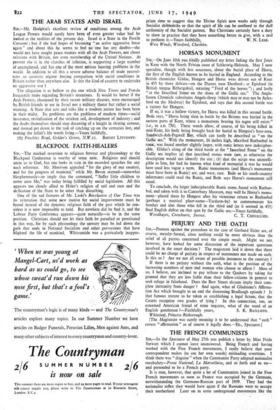HORSA'S MONUMENT
Sis,—On June 10th you kindly published my letter linking the first Jutes in Kent with the North Frisian coast of Schleswig-Holstein. May I now speculate, though with less assurance, about the burial place of Horsa, the first of the English known to be buried in England. According to the British chronicler Gildas, Hengest and Horsa were driven out of Kent in 455 by three defeats—on the Darent near Dartford ; at Episford (in British tongue Rithergabail, meaning " Ford of the horses ") ; and lastly " at the Inscribed Stone on the shore of the Gallic sea." The Anglo- Saxon Chronicle substitutes Angels-threp (which may or may not be Ayles- ford on the Medway) for Episford, and says that this second battle was a victory for Hengest.
If so, it was a hollow victory, for Horsa was killed in this second battle. Bede says, " Horsa being slain in battle by the Britons was buried in the eastern parts of Kent, where a monument bearing his naine still exists " (i.e., in A.D. 730). These words allow, of course, of his being killed in mid-Kent, his body being brought back for burial to Hengest's base-area, Sandwich-Ash-Pegwell Bay, which can justly be described as " on the Gallir sea." With the monument, 16 inches high, inscribed Raehaebul in runic, was found another slightly larger, with runic letters now indecipher- able. Gildas's siting of the third battle at the " Inscribed Stone " on the Gallic sea implies (a) that inscribed stones were rare, as otherwise the description would not identify the site ; (b) that the script was unintelli- gible to for had he known what kind of memorial it was he would have used less vague a term. Runic monuments (and Horsa's monument must have been in Runic) are, and were, rare. Bede or his south-country informants could read the Runic, and Bede says Horsa's monument still stood.
To conclude, the larger indecipherable Runic stone, found with Raehae- bul, and taken with it to Canterbury Museum, may well be Horsa's monu- ment—placed there by Hengest after his victorious return to Raehaebul (perhaps a nautical place-name--Yardarm-by) to commemorate his brother and also those who fell in the third and (as it seemed in 455) final English defeat on that spot by the Gallic sea.—Yours faithfully,






































 Previous page
Previous page